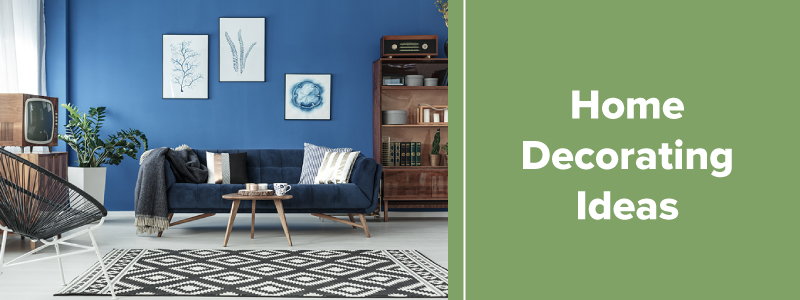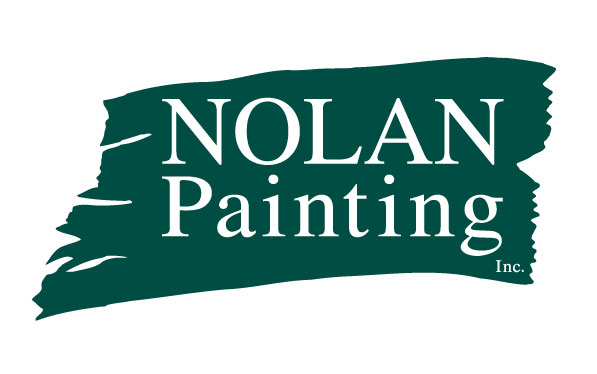Home Decorating Tips
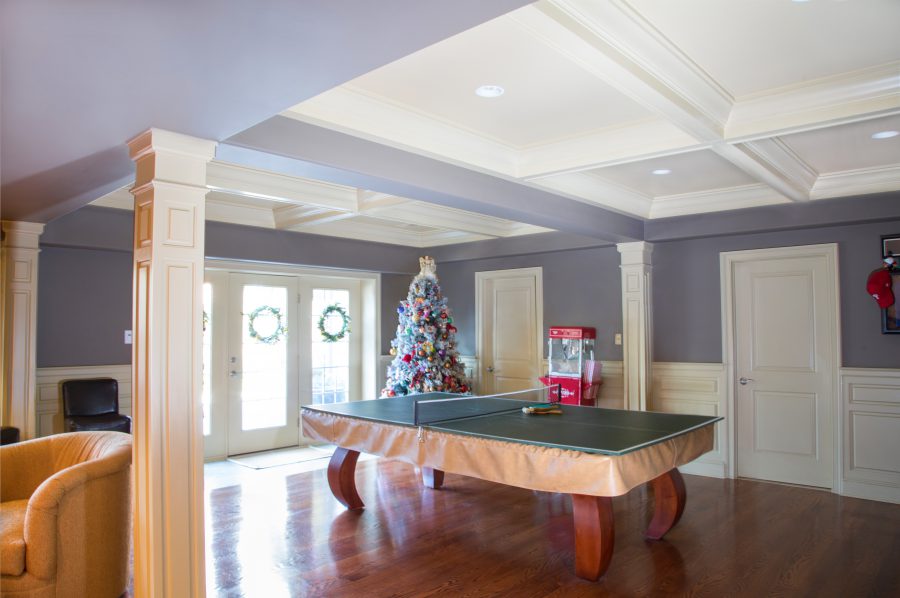
Your house isn’t just a place to live. It’s the place you wake up every morning with sleepy eyes and a fresh start. It’s the place you come back to every evening to rest and recharge, no matter what happens out there in the office, the classroom or the world. It’s where you find your independence, where you start a new life on your own or together, where you raise your children and where your grandchildren come to play. Your house is more than a house. It’s a home, and you want it to look as uniquely yours as it feels.
So how can you create a home that visually matches your personality, meets your needs and expresses your style? Through painting and home design, of course! With creative painting and decorating ideas, you can find the perfect mood for every room and transform your home into a space that warms your heart, inspires your imagination and fits your family.
When it comes to color and home décor, the possibilities for your walls are boundless. Transform your home office into the cool, calming oasis you need to fuel thought, or give your kitchen a bright, sunny makeover. Warm your living room with autumnal hues, or let your children’s individuality show by painting their rooms to match their interests. Whether you’re looking for a sleek, modern feel or a rustic, country influence, there’s a painting style for you.
And don’t think your options end with paint shades and two-dimensional ideas. With bold patterns, designs, textures and techniques, professional painters can transform rooms in ways that are surprising, vibrant and distinctly individualized. Your personality and style can jump off the walls when you incorporate unique molding, ceiling design, doors and accent elements as well.
Ready to revamp your home? These innovative inspirations for house painting will revolutionize your space by channeling your vibe, accenting your décor and adding new energy.
Paint Types

Did you know that the U.S. produces more than one billion gallons of paint every year? Of that, up to 10 percent can be disposed of without use.
To avoid contributing to this waste, and to make sure you’re using paint that will be long-lasting and fitting for your home, look into paint types before you order your house painting project. Find a stain-blocking primer to mask flaws in your wall or ceiling and make sure you have the right type of paint to adhere to materials if you’re planning on painting something other than a wall, like molding. Double check that the paint you choose comes in the right colors and is suited to the home painting technique or decorating idea you have in mind for your space.
Color Scheme
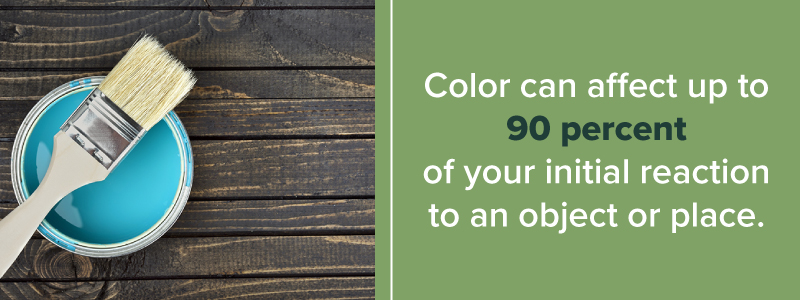
When it comes to identifying with a space, nothing is more important than a color scheme. In fact, color can affect up to 90 percent of your initial reaction to an object or place. Of course, your psychological responses to color are unique to you — linked to your experiences, preferences, and personality.
As you decide on color choices for your rooms, think about your personal reactions to color and the mood you’d like to evoke. For instance, if you want an exercise room that is vibrant, lively, and invigorating, you might want to choose bright, warm hues like orange and yellow. If you prefer that your bedroom is peaceful and soothing, consider cooler colors like pale greens, blues, or violets. Browns and beiges might strike you as earthy and comforting, in which case they’re a good fit for your living room. And if you like your bathrooms clean and modern, a black-and-white combo theme could suit you perfectly.
You should also consider your doors, trim, texture, and molding when you’re choosing a paint color. What offsets your wall colors and accents the space tastefully? Pick complementary colors, soothing neutrals, or lighter shades to separate the different elements of your room.
Wall Painting and Home Decorating Ideas
If you’d like to go beyond just painting your walls all one color, there are plenty of options you can try. And don’t forget to pull in other features as well! Ceilings, doors and trim can play an integral part in your room design, and you can make them work with your walls in tasteful and trendy ways. Here are some unique wall painting and home decorating ideas to give your space a touch of your unique personality and style.
Ombre
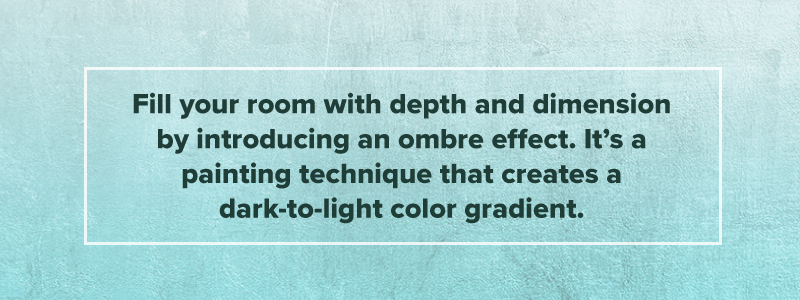
If one flat color seems too simple for your walls, but you don’t want to introduce a completely new element, you can add dimension to your space without compromising your color scheme. Fill your room with depth and dimension by introducing an ombre effect. It’s a painting technique that creates a dark-to-light color gradient. This style is timeless and beautifully executed by painting professionals. Even better, it offers unique flexibility in style. Shift your ombre from side to side, dark to light, light to dark, bottom to top, and vice versa.
You can even incorporate more than one color if you want to accent your décor or create a specific mood. Blending the boundaries between wall and ceiling and creating illusions that eliminate straight angles, so ombre is the perfect style to soften your space.
Wallpaper/Tape
Sometimes, wallpaper can be a perfect accent to a well-painted wall, and it comes in all colors, themes, and designs. Make your room classy, vintage, modern, or rustic by choosing a paper style that fits with your vision, style, and décor. Create a complementary balance on your walls by using wallpaper in strips, shapes, or as trimming.
If that’s too traditional for you, ask your painting professional to use painter’s tape to fit your design needs. Using straight tape organized in personalized patterns or torn tape with jagged, uneven edges, you can create unusual designs to decorate your space.
Molding
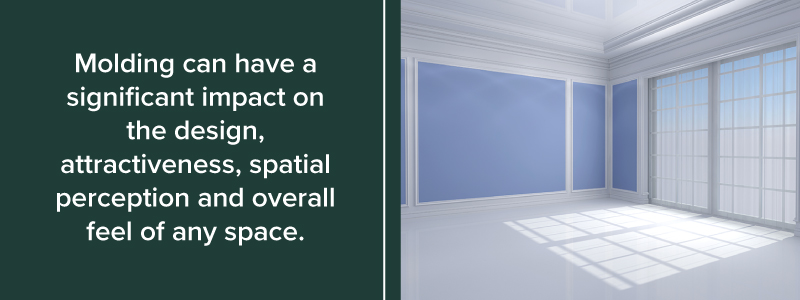
You might not think about it when you’re focused on the right color choice to set the mood for each room, but molding can have a significant impact on the design, attractiveness, spatial perception, and overall feel of any space.
What is it, exactly? Moldings consist of strips of wood or plaster that wrap around the walls of your room in different locations and designs to accentuate certain features or give specific visual impressions. You can install molding in multiple positions — along the bottom where the wall meets the floor, against the ceiling, in the middle of the wall or somewhere in between.
Like paint, moldings come in many forms. The myriad shapes and styles of molding serve different purposes. They can cover up flaws in the wall, for example, or they can serve to alter a room’s appearance. They can elegantly frame a door, window or walkway, make a room seem taller, shorter or wider, and provide decorative elegance or three-dimensional interest to your space. You can have your molding painted, stained or left natural, depending on your aesthetic goals and painting scheme. Molding design can have a huge effect on a room’s overall appearance.
Before you pick the best molding for each of your rooms, however, you should learn to differentiate between the types and how they can affect the walls. Here are the types of molding and what you can do with them:
- Casing: Usually about two to three inches in width, casing is a form of molding that frames and accentuates windows and doorframes while also serving to cover the gap between the fixture and the wall. Casing can come in many styles, and you can paint or stain it in specific ways to match or offset the color and pattern of your walls.
- Baseboards: Typically measuring three to five inches and offset with semi-circular trim at the bottom, baseboards are simple moldings that accentuate walls where they meet the floor. They can provide a visual break between wall color and carpet or floor material, separating styles tastefully and unifying the room.
- Chair Rail Molding: Covering the lower half of the wall, chair molding is often meant to protect walls from possible furniture damage, but it can be decorative as well. For example, it might separate two styles or colors of wall covering, like paint and wallpaper or wood trim.
- Picture Frame Molding: Often installed beneath chair rail molding on the lower half of the wall, picture frame molding is a decorative style that features rows of square or rectangular box frame moldings on the wall below another strip of molding. This design is both classy and innovative, providing texture and dimension for your walls. You can paint the boxes and molding the same color as the wall or make them a different, complementary color to add interest to the space.
- Crown Molding: Accentuating the meeting of the walls and ceiling, crown molding — sometimes called cornice molding — is intricate, decorative molding that crowns the room. It can come in different types, including double-crown molding, which uses two pieces — one along the ceiling and another, upside-down piece of baseboard topped with crown below. Crown molding adds an ornate, elegant finish to any wall.
- Picture Rail Molding: Positioned seven to nine feet above the floor, picture rail molding can be a hybrid or combination of crown molding. This type of molding makes it possible to hang artwork and photo frames from the walls without driving nails into your paint.
- Cove Molding: A less elaborate version of crown molding, cove molding also decorates the meeting of the wall and ceiling and can accentuate stairs as well. It’s typically simple and concave, creating a tasteful look that isn’t too ornate.
- Batten: Also described as board-and-batten, this type of trim is simple, rustic, and usually serves the purpose of hiding joints between paneling.
- Bead and Pearl Molding: Both of these types of molding are made up of a row of small spheres or knobs above another molding like crown or chair railing.
When deciding what type of molding will suit your wall best in terms of architectural accenting and paint cohesiveness, think about the nature of your room and vision. Here are some tips for picking the perfect molding:
- Consider Ceiling Height and Home Style- Examine your room and pay close attention to its height and dimensions. Tall, wide rooms are often the best fit for more intricate molding like crown, while simpler styles will most likely suit smaller, shorter spaces better. The style of your home also factors into room type and molding choice. Classy, ornate molding types look better in more traditional homes, but for contemporary architecture, try trimming with a tasteful, simple, geometric nature.
- Match to Your Décor- Consider the style of your furniture and decorations when incorporating molding. Art deco furnishings won’t necessarily match well with elaborate double crown molding, just like antique chairs and tables wouldn’t compliment a board-and-batten wall. You want rooms that are cohesive and fitting to your aesthetic vision, so make sure the size, style, and color of your décor mesh well with the type of molding you choose.
- Keep Material in Mind- Do you want an intricate look with rich, crisp detail, or are you more interested in a room that’s rustic and down-to-earth? Decide whether you’d prefer the cool ornamentation of plaster or the sturdy nature of wood trim that you can paint or stain.
Remember, you can always combine molding types for a unique style that spices up the whole wall or keeps it classy. It’s all about aesthetics and dimension, and along with the right coat of paint, a well-informed molding choice can make your room pop in just the way you want.
Ceiling Beadboard
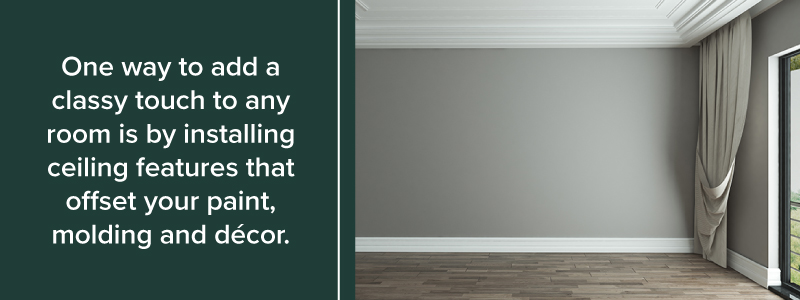
When you’re thinking about how to beautify your walls, don’t forget to factor in the ceiling. One way to add a classy touch to any room is by installing ceiling features that offset your paint, molding and décor. Beadboard panels are a simple and tasteful way to add texture and detail without compromising your design scheme.
Installing a beadboard ceiling can cover outdated styles and imperfections, contribute to a more finished look and still keep the same ceiling height. White panels are traditional and add more light into a space, but you can also choose to paint them to match or complement your walls and trimming. Run beadboard planks parallel or perpendicular to floorboards for class and continuity or contrast.
Painted Ceilings
If you’d like to incorporate your ceiling into your room design, but you don’t want to invest in extra materials and installments, you can always choose a coat of paint for the ceiling as well.
Matching your ceiling color to the walls will close in your space, but that can work for you if you want a cozy feel or you’d like to lessen the stark appearance of corners and creases. To open up your space, choose a lighter, complementary color that remains true to the room’s color scheme. If you’re covering your walls in a soothing forest green, for example, you might choose to offset the tone with an earthy-toned coat of cream, tan or paler green for your ceiling. Ask your painting professional about the right choice of ceiling shade to suit your space.
Interior Black Doors and Matching Exteriors
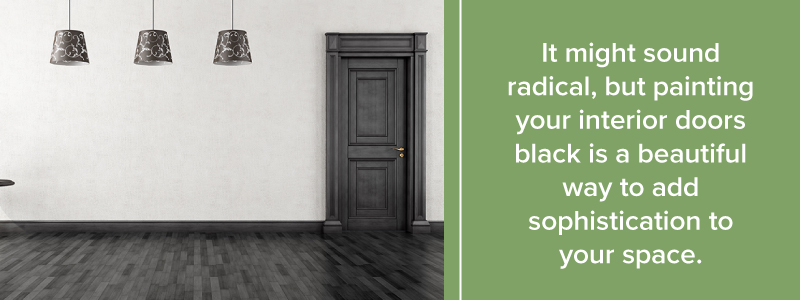
Doors are an important aspect of any room, and when you’ve paid so much attention to your wall design, you won’t always want to leave them plain. It might sound radical, but painting your interior doors black is a beautiful way to add sophistication to your space. Black doors are elegant, good at framing home architecture, perfect for picking up other black accents in the room and useful for opening up a room with the appearance of a void, which draws the eye to create an illusion of more space.
And don’t forget your front door. While it might seem standard to match the inside of your entrance door with the color of the surrounding walls or to keep it a simple white, try painting it the same shade as the outside or exterior accents of your house. This technique creates unique continuity from the exterior to the interior of your home.
Accent Walls
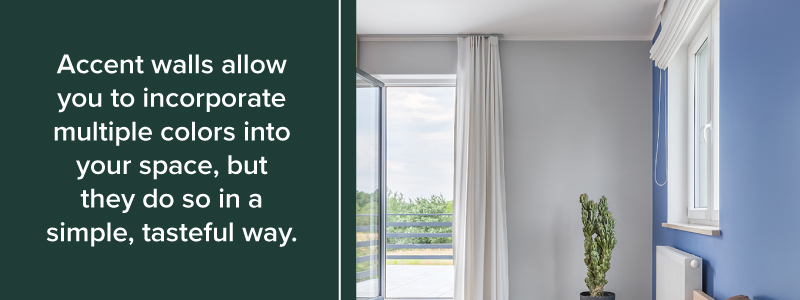
Maybe you’d like to step out of the traditional fallback of four uniform walls, but you don’t know how to paint your room in more than one shade without making a visual mistake. Accent walls allow you to incorporate multiple colors into your space, but they do so in a simple, tasteful way. While three of your walls are painted one color, you will choose one wall to offset your furniture, décor, and color scheme with a different color or shade.
For a light, breezy room of ocean blue, paint one wall light tan to vary the seaside theme. If you want a rustic, rich accent for your golden brown walls, try an accent wall of gorgeous cranberry. The wall and color choice are up to you, and they can make all the difference in how your space shines.
This technique opens up space, creates visual variability and can draw the eye to a specific feature. For example, choose your accent wall to illuminate your fireplace, offset your bedframe or serve as a backdrop for your photo collection. Accent walls are a refreshing feature that’s always in style.
Shiplap Accent Walls
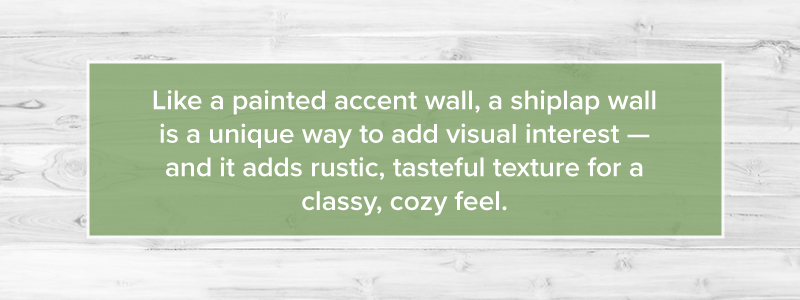
Like a painted accent wall, a shiplap wall is a unique way to add visual interest — and it adds rustic, tasteful texture for a classy, cozy feel. Shiplap panels have grooved edges that fit together for an overlapping, tight style on your wall. Choose from different types of wood, grains, thicknesses, and lengths to craft the kind of wall you desire.
If you love the look of your grain and your house incorporates a country-style, leave the wood panels in their natural state or stain them specifically to match your furniture. If you’d rather sport a finished style to create elegance, sand, finish, and paint them in the color of your choice. Like a beadboard ceiling, a shiplap accent wall can create a subtle, tasteful, customizable element of texture and visual stimulation to your newly-painted space. Offset it with similar furniture, wooden décor, or matching elements around the room.
Crafting Your Dream
You want a home that matches your unique style — a space that meets your needs as well as expresses your personality and inspires your imagination. And you don’t just hope for your home painting job to carry an immediate wow factor. You want it to hold up and be easy to maintain, too.
At Nolan Painting, a family business experienced in improving homes since 1979, we understand that your house is more than just a place to live. It’s an extension of yourself, a canvas for your family, and a springboard for your dreams. With a team of more than 100 community-minded, people-oriented professionals trained in painting, we are dedicated to helping you visualize, execute and maintain the home of your dreams. We work green and clean with the highest quality materials and technology, and our painters are experts in preparation and application. We will start and finish on a timely basis, keep your home neat and follow through with our promise for your happiness.
We guarantee 100 percent customer satisfaction. Whatever your inspirations and ideas, Nolan Painting listens to your needs and works to match your personal vision for your home painting job. You can trust us to transform your house into the unique home you’ve been dreaming of. Take the first step today, and schedule a consultation for a free estimate.

